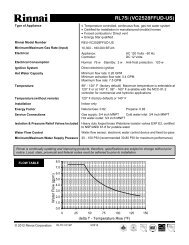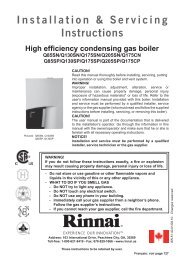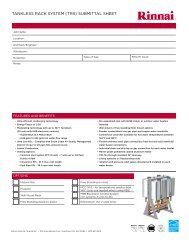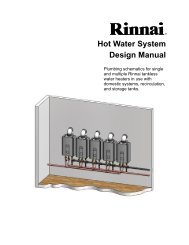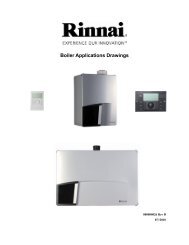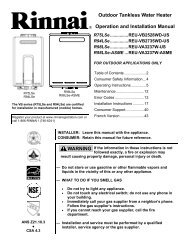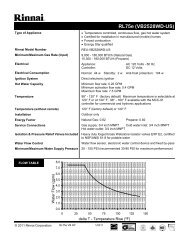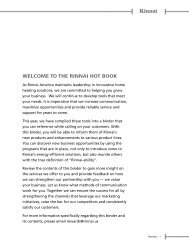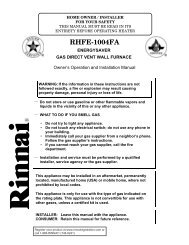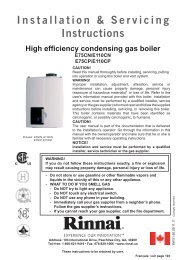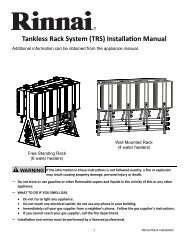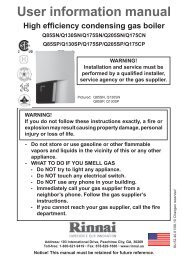Direct Vent Tankless Water Heater - Rinnai
Direct Vent Tankless Water Heater - Rinnai
Direct Vent Tankless Water Heater - Rinnai
Create successful ePaper yourself
Turn your PDF publications into a flip-book with our unique Google optimized e-Paper software.
Electrical Connection<br />
The water heater requires 120 VAC, 60 Hz power from a properly grounded circuit.<br />
If using the 6 foot long power cord, plug it into a standard 3 prong 120 VAC, 60 Hz properly grounded wall outlet.<br />
The wiring diagram is located on the Technical Sheet attached to the inside of the front cover.<br />
The water heater must be electrically grounded in accordance with local codes, or in the absence of local codes<br />
with the National Electrical Code, ANSI/NFPA 70 and/or the CSA C22.1, Canadian Electrical Code.<br />
Error Indication or Air Handler Control Switch (RL75i, and RL94i only)<br />
When using the <strong>Rinnai</strong> water heater with an Error Indication Switch, switch No. 4 in the bank of 8 switches should<br />
be in the off position. This is the default position.<br />
To connect the water heater to the <strong>Rinnai</strong> Air Handler, the Control Switch is necessary to function as the electrical<br />
connection. When the Control Switch is functioning as the electrical connection between the water heater and air<br />
handler, switch No. 4 in the bank of 8 switches should be in the on position.<br />
The Error Indication Switch and the <strong>Rinnai</strong> Air Handler Control Switch are optional products available from <strong>Rinnai</strong>.<br />
Installation instructions are included with these products.<br />
Gas Piping<br />
General Instructions<br />
• A manual gas control valve must be placed in the<br />
gas supply line to the <strong>Rinnai</strong> water heater. A union<br />
can be used on the connection above the shut off<br />
valve for the future servicing or disconnection of the<br />
unit.<br />
• Check the type of gas and the gas inlet pressure<br />
before connecting the <strong>Rinnai</strong> water heater. If the<br />
<strong>Rinnai</strong> water heater is not of the gas type that the<br />
building is supplied with, DO NOT connect the water<br />
heater. Contact the dealer for the proper unit to<br />
match the gas type.<br />
• Check the gas supply pressure immediately<br />
upstream at a location provided by the gas<br />
company. Supplied gas pressure must be within the<br />
limits shown in the Specifications section.<br />
• Before placing the appliance in operation all joints<br />
including the heater must be checked for gas<br />
tightness by means of leak detector solution, soap<br />
and water, or an equivalent nonflammable solution,<br />
as applicable. (Since some leak test solutions,<br />
18 VB Series Indoor LS Manual<br />
including soap and water, may cause corrosion or<br />
stress cracking, the piping shall be rinsed with water<br />
after testing, unless it has been determined that the<br />
leak test solution is non-corrosive.)<br />
• Always use approved connectors to connect the unit<br />
to the gas line. Always purge the gas line of any<br />
debris before connection to the water heater.<br />
• The gas supply line shall be gas tight, sized, and so<br />
installed as to provide a supply of gas sufficient to<br />
meet the maximum demand of the heater and all<br />
other gas consuming appliances at the location<br />
without loss of pressure.<br />
• Any compound used on the threaded joint of the gas<br />
piping shall be a type which resists the action of<br />
liquefied petroleum gas (propane / LPG).<br />
• Refer to an approved pipe sizing chart if in doubt<br />
about the size of the gas line.



